
Bison hunting
Encyclopedia
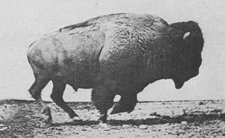
Native hunting
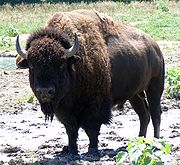
Bering Strait
The Bering Strait , known to natives as Imakpik, is a sea strait between Cape Dezhnev, Chukotka Autonomous Okrug, Russia, the easternmost point of the Asian continent and Cape Prince of Wales, Alaska, USA, the westernmost point of the North American continent, with latitude of about 65°40'N,...
. About 10,000 years ago it replaced the steppe bison (Bison priscus
Steppe Wisent
The Steppe Bison or steppe wisent was a bison found on steppes throughout Europe, Central Asia, Beringia, and North America during the Quaternary...
), a previous immigrant that was much larger. It is thought that the long-horned bison became extinct due to a changing ecosystem and hunting pressure following the development of the Clovis point
Clovis point
Clovis points are the characteristically-fluted projectile points associated with the North American Clovis culture. They date to the Paleoindian period around 13,500 years ago. Clovis fluted points are named after the city of Clovis, New Mexico, where examples were first found in 1929.At the right...
and related technology, and improved hunting skills. During this same period, other megafauna
Megafauna
In terrestrial zoology, megafauna are "giant", "very large" or "large" animals. The most common thresholds used are or...
vanished and were replaced to some degree by immigrant Eurasian animals that were better adapted to predatory humans. The American bison, technically a dwarf form, was one of these animals. The American bison's ancestor, Bison antiquus
Bison antiquus
Bison antiquus, sometimes called the ancient bison, was the most common large herbivore of the North American continent for over ten thousand years, and is a direct ancestor of the living American bison....
, was a breed with longer horns than the modern North American animal, but was not the same as the steppe bison.
Bison were a keystone species
Keystone species
A keystone species is a species that has a disproportionately large effect on its environment relative to its abundance. Such species play a critical role in maintaining the structure of an ecological community, affecting many other organisms in an ecosystem and helping to determine the types and...
, whose grazing pressure was a force that shaped the ecology of the Great Plains
Great Plains
The Great Plains are a broad expanse of flat land, much of it covered in prairie, steppe and grassland, which lies west of the Mississippi River and east of the Rocky Mountains in the United States and Canada. This area covers parts of the U.S...
as strongly as periodic prairie fire
Wildfire
A wildfire is any uncontrolled fire in combustible vegetation that occurs in the countryside or a wilderness area. Other names such as brush fire, bushfire, forest fire, desert fire, grass fire, hill fire, squirrel fire, vegetation fire, veldfire, and wilkjjofire may be used to describe the same...
s and which were central to the lifestyle of American Indians of the Great Plains
Plains Indians
The Plains Indians are the Indigenous peoples who live on the plains and rolling hills of the Great Plains of North America. Their colorful equestrian culture and resistance to White domination have made the Plains Indians an archetype in literature and art for American Indians everywhere.Plains...
. However, there is now some controversy over their interaction. "Hernando De Soto's expedition staggered through the Southeast for four years in the early 16th century and saw hordes of people but apparently did not see a single bison," Charles C. Mann wrote in 1491: New Revelations of the Americas Before Columbus
1491: New Revelations of the Americas Before Columbus
1491: New Revelations of the Americas Before Columbus is a 2005 non-fiction book by American author and science writer Charles C. Mann about the pre-Columbian Americas...
. Mann discussed the evidence that Native Americans not only created (by selective use of fire) the large grasslands that provided the bison's ideal habitat but also kept the bison population regulated. In this theory, it was only when the original human population was devastated by wave after wave of epidemic (from diseases of Europeans) after the 16th century that the bison herds propagated wildly. In such a view, the seas of bison herds that stretched to the horizon were a symptom of an ecology out of balance, only rendered possible by decades of heavier-than-average rainfall. Other evidence of the arrival circa 1550–1600 in the savannas of the eastern seaboard
Eastern savannas of the United States
The eastern savannas of the United States covered large portions of the east side of the continent until the early 20th century. These were in a fire ecology of open grassland and forests with low ground cover of herbs and grasses....
includes the lack of places which southeast natives named after buffalo. Bison were the most numerous single species of large wild mammal on Earth.
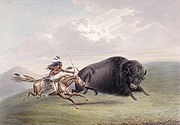
Horse
The horse is one of two extant subspecies of Equus ferus, or the wild horse. It is a single-hooved mammal belonging to the taxonomic family Equidae. The horse has evolved over the past 45 to 55 million years from a small multi-toed creature into the large, single-toed animal of today...
s, bison were herded into large chutes made of rocks and willow branches and then stampeded over cliffs. These Buffalo jump
Buffalo jump
A buffalo jump is a cliff formation which North American Indians historically used in mass killings of plains bison. Hunters herded the bison and drove them over the cliff, breaking their legs and rendering them immobile. Tribe members waiting below closed in with spears and bows to finish the kills...
s are found in several places in the U.S. and Canada, such as Head-Smashed-In Buffalo Jump
Head-Smashed-In Buffalo Jump
Head-Smashed-In Buffalo Jump is a buffalo jump located where the foothills of the Rocky Mountains begin to rise from the prairie 18 km northwest of Fort Macleod, Alberta, Canada on highway 785...
. Large groups of people would herd the bison for several miles, forcing them into a stampede
Stampede
A stampede is an act of mass impulse among herd animals or a crowd of people in which the herd collectively begins running with no clear direction or purpose....
that would ultimately drive many animals over a cliff. The large quantities of meat obtained in this way provided the hunters with surplus, which was used in trade.
A similar method of hunting was to drive the bison into natural corrals, such as the Ruby site
Ruby site
The Ruby site is a Native American site located in Wyoming. It is located on a dry tributary of the Powder River. The Ruby site is a corral that was used to herd bison. The bison were forced to stampede by the hunters and then ran into the enclosure which was in a low lying area...
.
To get the optimum use out of the bison, the Native Americans had a specific method of butchery, first identified at the Olsen-Chubbuck
Olsen-Chubbuck Bison Kill Site
The Olsen-Chubbuck Bison kill site is located southeast of Kit Carson, Colorado. The Paleo-Indian site dates back to an estimated 8000-6500 B.C. and provides evidence for bison hunting long before the use of the bow and arrow or horses. The site was named Olsen-Chubbuck after the amateur...
archaeological site in Colorado
Colorado
Colorado is a U.S. state that encompasses much of the Rocky Mountains as well as the northeastern portion of the Colorado Plateau and the western edge of the Great Plains...
. The method involves skinning down the back in order to get at the tender meat just beneath the surface, the area known as the "hatched area." After the removal of the hatched area, the front legs are cut off as well as the shoulder blades. Doing so exposes the hump meat (in the Wood Bison), as well as the meat of the ribs and the Bison's inner organs. After everything was exposed, the spine was then severed and the pelvis and hind legs removed. Finally, the neck and head were removed as one. This allowed for the tough meat to be dried and made into pemmican
Pemmican
Pemmican is a concentrated mixture of fat and protein used as a nutritious food. The word comes from the Cree word pimîhkân, which itself is derived from the word pimî, "fat, grease". It was invented by the native peoples of North America...
.
Later when Plains Indians obtained horses, it was found that a good horseman could easily lance or shoot enough bison to keep his tribe and family fed, as long as a herd was nearby. The bison provided meat, leather, sinew for bows, grease, dried dung for fires, and even the hooves could be boiled for glue. When times were bad, bison were consumed down to the last bit of marrow
Bone marrow
Bone marrow is the flexible tissue found in the interior of bones. In humans, bone marrow in large bones produces new blood cells. On average, bone marrow constitutes 4% of the total body mass of humans; in adults weighing 65 kg , bone marrow accounts for approximately 2.6 kg...
.
19th century bison hunts
Bison were hunted almost to extinctionExtinction
In biology and ecology, extinction is the end of an organism or of a group of organisms , normally a species. The moment of extinction is generally considered to be the death of the last individual of the species, although the capacity to breed and recover may have been lost before this point...
in the 19th century and were reduced to a few hundred by the mid-1880s. They were hunted for their skins, with the rest of the animal left behind to decay on the ground. After the animals rotted, their bones were collected and shipped back east in large quantities.
The US Army sanctioned and actively endorsed the wholesale slaughter of bison herds. The federal government promoted bison hunting for various reasons, to allow ranchers to range their cattle without competition from other bovines, and primarily to weaken the North American Indian population by removing their main food source and to pressure them onto the reservations. Without the bison, native people of the plains were forced to leave the land or starve to death.
According to historian Pekka Hämäläinen
Pekka Hämäläinen
Pekka Hämäläinen is an associate professor of history at University of California at Santa Barbara and an author.-Life:He graduated from University of Helsinki, with a Ph.D. in 2001.He taught at Texas A&M University from 2002 to 2004....
, Native Americans also contributed to the collapse of the bison. By the 1830s the Comanche
Comanche
The Comanche are a Native American ethnic group whose historic range consisted of present-day eastern New Mexico, southern Colorado, northeastern Arizona, southern Kansas, all of Oklahoma, and most of northwest Texas. Historically, the Comanches were hunter-gatherers, with a typical Plains Indian...
and their allies on the southern plains were killing about 280,000 bison a year, which was near the limit of sustainability for that region. Firearms and horses, along with a growing export market for buffalo robes and bison meat had resulted in larger and larger numbers of bison killed each year. A long and intense drought hit the southern plains in 1845, lasting into the 1860s, which caused a widespread collapse of the bison herds. In the 1860s, the rains returned and the bison herds recovered to a degree.
The railroad industry also wanted bison herds culled or eliminated. Herds of bison on tracks could damage locomotives when the trains failed to stop in time. Herds often took shelter in the artificial cuts formed by the grade of the track winding though hills and mountains in harsh winter conditions. As a result, bison herds could delay a train for days.
The main reason for the bison's near-demise, much like the actual demise of the Passenger Pigeon
Passenger Pigeon
The Passenger Pigeon or Wild Pigeon was a bird, now extinct, that existed in North America and lived in enormous migratory flocks until the early 20th century...
, was commercial hunting.
Bison skins were used for industrial machine belts, clothing such as robes, and rugs. There was a huge export trade to Europe of bison hides. Old West bison hunting was very often a big commercial enterprise, involving organized teams of one or two professional hunters, backed by a team of skinners, gun cleaners, cartridge
Cartridge (firearms)
A cartridge, also called a round, packages the bullet, gunpowder and primer into a single metallic case precisely made to fit the firing chamber of a firearm. The primer is a small charge of impact-sensitive chemical that may be located at the center of the case head or at its rim . Electrically...
reloaders, cooks, wranglers, blacksmiths, security guards, teamsters, and numerous horses and wagons. Men were even employed to recover and recast lead bullets taken from the carcasses. Many of these professional hunters, such as Buffalo Bill Cody
Buffalo Bill
William Frederick "Buffalo Bill" Cody was a United States soldier, bison hunter and showman. He was born in the Iowa Territory , in LeClaire but lived several years in Canada before his family moved to the Kansas Territory. Buffalo Bill received the Medal of Honor in 1872 for service to the US...
, killed over a hundred animals at a single stand and many thousands in their career. One professional hunter killed over 20,000 by his own count. A good hide could bring $3 in Dodge City
Dodge City, Kansas
Dodge City is a city in, and the county seat of, Ford County, Kansas, United States. Named after nearby Fort Dodge, the city is famous in American culture for its history as a wild frontier town of the Old West. As of the 2010 census, the city population was 27,340.-History:The first settlement of...
, Kansas
Kansas
Kansas is a US state located in the Midwestern United States. It is named after the Kansas River which flows through it, which in turn was named after the Kansa Native American tribe, which inhabited the area. The tribe's name is often said to mean "people of the wind" or "people of the south...
, and a very good one (the heavy winter coat) could sell for $50 in an era when a laborer would be lucky to make a dollar a day.
The hunter would customarily locate the herd in the early morning, and station himself about 100 yards (91.4 m) from it, shooting the animals broadside through the lungs. Head shots were not preferred as the soft lead bullets would often flatten and fail to penetrate the skull, especially if mud was matted on the head of the animal. The bison would drop until either the herd sensed danger and stampeded or perhaps a wounded animal attacked another, causing the herd to disperse. If done properly a large number of bison would be felled at one time. Following up were the skinners, who would drive a spike through the nose of each dead animal with a sledgehammer
Sledgehammer
A sledgehammer is a tool consisting of a large, flat head attached to a lever . The head is typically made of metal. The sledgehammer can apply more impulse than other hammers, due to its large size. Along with the mallet, it shares the ability to distribute force over a wide area...
, hook up a horse team, and pull the hide from the carcass. The hides were dressed, prepared, and stacked on the wagons by other members of the organization.
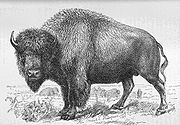
.50-90 Sharps
The .50-90 Sharps rifle cartridge is a black powder cartridge that was introduced by Sharps Rifle Manufacturing Company in 1872 as a buffalo hunting round...
were fired so much that hunters needed at least two rifles to let the barrels cool off; The Fireside Book of Guns reports they were sometimes quenched in the winter snow. Dodge City saw railroad cars sent East filled with stacked hides.
The building of the railroads through Colorado and Kansas split the bison herd in two parts, the southern herd and the northern herd. The last refuge of the southern herd was in the Texas panhandle.
As the great herds began to wane, proposals to protect the bison were discussed. Cody, among others, spoke in favor of protecting the bison because he saw that the pressure on the species
Species
In biology, a species is one of the basic units of biological classification and a taxonomic rank. A species is often defined as a group of organisms capable of interbreeding and producing fertile offspring. While in many cases this definition is adequate, more precise or differing measures are...
was too great. Yet these proposals were discouraged since it was recognized that the Plains Indians, often at war with the United States, depended on bison for their way of life. In 1874, President Ulysses S. Grant
Ulysses S. Grant
Ulysses S. Grant was the 18th President of the United States as well as military commander during the Civil War and post-war Reconstruction periods. Under Grant's command, the Union Army defeated the Confederate military and ended the Confederate States of America...
"pocket veto
Pocket veto
A pocket veto is a legislative maneuver in United States federal lawmaking that allows the President to veto a bill indirectly.The U.S. Constitution limits the President's period for decision on whether to sign or veto any legislation to ten days while the United States Congress is in session...
ed" a Federal bill to protect the dwindling bison herds, and in 1875 General Philip Sheridan
Philip Sheridan
Philip Henry Sheridan was a career United States Army officer and a Union general in the American Civil War. His career was noted for his rapid rise to major general and his close association with Lt. Gen. Ulysses S...
pleaded to a joint session of Congress
United States Congress
The United States Congress is the bicameral legislature of the federal government of the United States, consisting of the Senate and the House of Representatives. The Congress meets in the United States Capitol in Washington, D.C....
to slaughter the herds, to deprive the Indians of their source of food. By 1884, the American Bison was close to extinction.
Comeback
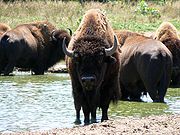
Grand River (South Dakota)
The Grand River is a tributary of the Missouri River in North Dakota and South Dakota in the United States. The length of the combined branch is 110 mi...
in 1881 and taken them back home to the ranch on the Cheyenne River
Cheyenne River
The Cheyenne River is a tributary of the Missouri River in the U.S. states of Wyoming and South Dakota. It is approximately 295 mi long and drains an area of...
. By 1889, these 5 rescued buffalo calves had grown to a herd of 74 head. Philip's goal was to preserve the animal from extinction. At the time of his death in 1911 at 53, Philip's herd had grown to an estimated 1,000 to 1,200 head of bison. A variety of privately owned herds had also been established, starting from this population.
Simultaneously, two Montana ranchers, Michel Pablo and Charles Allard, spent more than 20 years assembling one of the largest collections of purebred bison on the continent (by the time of Allard's death in 1896, the herd numbered 300). In 1907, after U.S. authorities declined to buy the herd, Pablo struck a deal with the Canadian government and shipped most of his bison northward to the newly created Elk Island National Park
Elk Island National Park
Elk Island National Park , is one of 43 national parks and park reserves administered by the Parks Canada Agency. This “island of conservation” is located 35 km east of Edmonton, Alberta along the Yellowhead Highway, which nearly bisects the park...
.
An isolated bison herd on Utah's Antelope Island
Antelope Island
Antelope Island, with an area of , is the largest island of 10 islands located within the Great Salt Lake, Utah, United States. The island lies in the southeastern portion of the lake, near Salt Lake City and Davis County, and becomes a peninsula when the lake is at extremely low levels. Antelope...
has also been used to improve the genetic diversity of American Bison. The current American Bison population has been growing rapidly and is estimated at 350,000 compared to an estimated 60 to 100 million in the mid-19th century. Most current herds, however are genetically polluted
Genetic pollution
Genetic pollution is a controversial term for uncontrolled gene flow into wild populations. This gene flow is undesirable according to some environmentalists and conservationists, including groups such as Greenpeace, TRAFFIC, and GeneWatch UK.-Usage:...
or partly crossbred with cattle. Today there are only four genetically unmixed herds and only one that is also free of brucellosis
Brucellosis
Brucellosis, also called Bang's disease, Crimean fever, Gibraltar fever, Malta fever, Maltese fever, Mediterranean fever, rock fever, or undulant fever, is a highly contagious zoonosis caused by ingestion of unsterilized milk or meat from infected animals or close contact with their secretions...
: it roams Wind Cave National Park
Wind Cave National Park
Wind Cave National Park is a United States national park north of the town of Hot Springs in western South Dakota. Established in 1903 by President Theodore Roosevelt, it was the seventh U.S. National Park and the first cave to be designated a national park anywhere in the world. The cave is...
. A founder population of 16 animals from the Wind Cave herd was established in Montana
Montana
Montana is a state in the Western United States. The western third of Montana contains numerous mountain ranges. Smaller, "island ranges" are found in the central third of the state, for a total of 77 named ranges of the Rocky Mountains. This geographical fact is reflected in the state's name,...
in 2005 by the American Prairie Foundation. The herd now numbers near 100 and roams a 14000 acres (56.7 km²) grassland expanse on American Prairie Reserve.
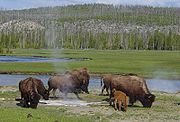
Yellowstone National Park
Yellowstone National Park, established by the U.S. Congress and signed into law by President Ulysses S. Grant on March 1, 1872, is a national park located primarily in the U.S. state of Wyoming, although it also extends into Montana and Idaho...
. Numbering between 3,000 and 3,500, this herd is descended from a remnant population of 23 individual mountain bison that survived the mass slaughter of the 19th century by hiding out in the Pelican Valley of Yellowstone Park. In 1902, a captive herd of 21 Plains bison were introduced to the Lamar Valley and managed as livestock until the 1960s, when a policy of natural regulation was adopted by the park.
The end of the ranching era and the onset of the natural regulation era set into motion a chain of events that have led to the bison of Yellowstone Park migrating to lower elevations outside the park in search of winter forage. The presence of wild bison in Montana is perceived as a threat to many cattle ranchers, who fear that the small percentage of bison that carry brucellosis will infect livestock and cause cows to abort their first calves. However, there has never been a documented case of brucellosis being transmitted to cattle from wild bison. The management controversy that began in the early 1980s continues to this day, with advocacy groups arguing that the Yellowstone herd should be protected as a distinct population segment under the Endangered Species Act
Endangered Species Act
The Endangered Species Act of 1973 is one of the dozens of United States environmental laws passed in the 1970s. Signed into law by President Richard Nixon on December 28, 1973, it was designed to protect critically imperiled species from extinction as a "consequence of economic growth and...
.
Bison hunting today

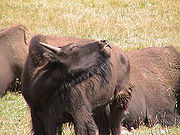
Alberta
Alberta is a province of Canada. It had an estimated population of 3.7 million in 2010 making it the most populous of Canada's three prairie provinces...
, where one of only two continuously wild herds of bison exist in North America at Wood Buffalo National Park
Wood Buffalo National Park
Wood Buffalo National Park, located in northeastern Alberta and southern Northwest Territories, is the largest national park in Canada at . The park was established in 1922 to protect the world's largest herd of free roaming Wood Bison, currently estimated at more than 5,000...
, bison are hunted to protect disease-free public (reintroduced) and private herds of bison.
In Montana, a public hunt was reestablished in 2005, with 50 permits being issued. The Montana Fish, Wildlife, and Parks Commission increased the number of tags to 140 for the 2006/2007 season. Advocacy groups claim that it is premature to reestablish the hunt, given the bison's lack of habitat and wildlife status in Montana.
Bison were also reintroduced to Alaska in 1928, and both domestic and wild herds subsist in a few parts of the state. The state grants limited permits to hunt wild bison each year.
The bison is one of the few North American large game animals that can be hunted year round.
Further reading
- Branch, E. Douglas. The Hunting of the Buffalo (1929, new ed. University of Nebraska Press, 1997), classic history online edition
- Barsness, Larry. Heads, Hides and Horns: The Compleat Buffalo Book. (Texas Christian University Press, 1974)
- Dary David A. The Buffalo Book. (Chicago: Swallow Press, 1974)
- Gard, Wayne. The Great Buffalo Hunt (University of Nebraska Press, 1954)
- Isenberg, Andrew C. The Destruction of the Buffalo: An Environmental History, 1750-1920 (Cambridge University press, 2000) online edition
- McHugh, Tom. The Time of the Buffalo (University of Nebraska Press, 1972).
- Meagher, Margaret Mary. The Bison of Yellowstone National Park. (Washington DC: Government Printing Office, 1973)
- Punke, Michael. Last Stand: George Bird Grinnell, the Battle to Save the Buffalo, and the Birth of the New West (Lincoln: University of Nebraska Press, 2009. xvi, 286 pp. isbn 978-0-8032-2680-7
- Roe, Frank Gilbert. The North American Buffalo: A Critical Study of the Species in Its Wild State (University of Toronto Press, 1951). and 26 (1995) 203-8.

